By Greg Hughes
Three boiler types loom large among conventional (non-condensing) commercial water boilers used for process or space heat, with input sizes of 400 MBH and up: those with cast iron sectional, fire-tube and water-tube heat exchangers.
For a variety of reasons, the latter two have been most prevalent in the commercial process heating market. Advantages include relatively compact size, lower standby heat loss, and the speed with which heat can be generated and delivered into distribution piping.
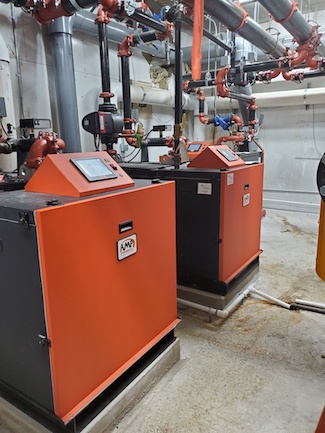
A Thermal Solutions AMP water-tube boiler is rated at 97% efficient. The stainless steel, modulating-condensing boiler line offers a size range of 1,000-4,000 MBH.
First out of the gate for a wide range of uses was the fire-tube boiler—with early design dating back centuries. Hollywood gave great prominence to horizontal fire-tube boilers, though few producers, actors or moviegoers were aware of it. Every time a steam locomotive—aka the iron horse—blew its whistle or raced across the great plains, an uncelebrated fire-tube boiler was doing its part.
Still today, fire-tube boilers offer a wide range of uses. Within these boilers, fire tubes are immersed in water; hot flue gases produced by the combustion chamber flow inside them. The hot flue gases transfer their heat to the outside water through the conduction.
Water-tube boiler designs, introduced later, essentially invert the fire-tube boiler construct: water is contained within the boiler’s internal tubes.
Water-tube advantages
In water-tube boilers, combustion occurs within the shell that surrounds the tubes, forcing combusted gas over the water tubes for exceptionally fast, efficient heat transfer.
Water-tube boilers offer quick startup and response time to changing conditions with very little standby loss. By design, comparatively little water passes through the heat exchanger; this translates into a smaller footprint and broader range of capabilities and output ranges.
“Their ability to make steam, or hot water, very rapidly, from a cold start, and without damaging the boiler is a beneficial asset,” said Lane Blackwell, Sales Engineer, Service, for Peru, Ind.-based Thornton & Associates,. Inc., a manufacturer’s rep firm. “This is valuable in applications where the systems aren’t running 24/7.”
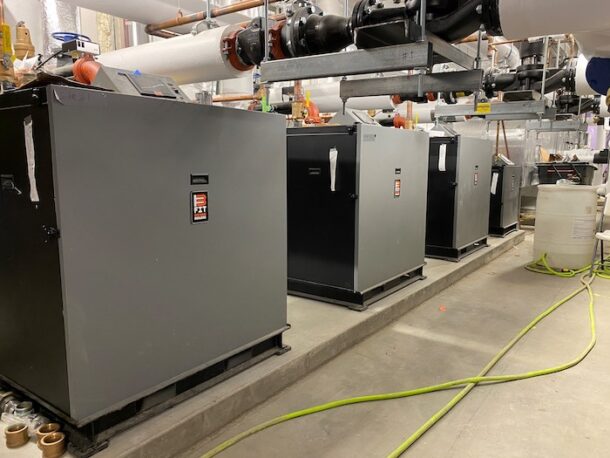
Bryan Boilers’ BFIT commercial condensing water-tube boiler series is a stainless steel, modulating-condensing boiler line with ranges from 1,000-4,000 MBH with optional racking system. Image courtesy of Bryan Boilers.
Because the burner in a water-tube boiler is located centrally, most water-tube designs provide higher temperature outputs and higher operational pressures than fire-tub boilers—key advantages for process heating application. Another advantage to the design of these systems is that, as a result of the requirement for water to flow continuously during operation, hot spots in the heat exchanger don’t threaten the operation or lifespan of the boiler.
Water-tube heat exchangers also operate at higher pressures, a capability that can—for steam-producing systems—produce saturated or superheated steam depending on the design and application they’re required for.
Blackwell also points to the advantage of water-tube maintenance, “Or, rather, lack of it. A surprisingly high number of water-tube systems may go several years without more than occasional attention to the water quality [within them], he said. “And, if there would be a need to replace individual tubes, that can be accomplished with hand tools; no rolling or welding. It’s not uncommon for a well-maintained water-tube boiler to last 40+ plus years with little maintenance.”
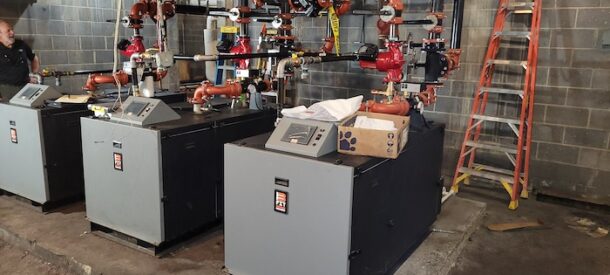
– Bryan Boilers’ BFIT commercial condensing water-tube boiler series is a stainless steel, modulating-condensing boiler line with ranges from 1,000-4,000 MBH with optional racking system. Image courtesy of Bryan Boilers.
“A few years ago, we specified two non-condensing water-tube boilers for a high school expansion project in Cass County [IN],” added Blackwell. “The boilers were 72 and 50 HP in size, and it wasn’t long before facility managers found that they could provide heat for the rest of the school with them, so they decommissioned two old, enormous—and way oversized—firetube boilers. The following year, they added another 100 HP water-tube system and, within a few years, they verified 30 to 40 percent annual fuel savings. I could reel-off countless instances where water-tube boilers have exceeded expectation.”
Water-tube systems are designed to work with high-ash fuels that, when combined with soot blowers, typically meet environmental regulations. This also means that they’re well-suited for biomass applications and waste-to-energy plants.
The primary factor that determines heat transfer is the heat transfer coefficient, based on the transfer fluid’s flow pattern, characteristics and chemistry (including density, conductivity and viscosity), geometry of the flow passage, and surface conditions. Of these factors, the most important to thermal efficiency in a water-tube boiler is flow through the water tubes and the fluid’s velocity and density. When all of these variables are optimal, water-tube boilers provide exceptionally reliable operation, while offering performance and efficiency that is difficult to match with any other heat exchanger design.
For these and other reasons, water-tube boilers are the equipment of choice for many industrial process applications. Their ability—in a steam boiler configuration—to handle greater pressures and very high temperatures provides superior steam generation in the millions of pounds/hr.
Caveats
Most advantages come with a counterbalance; water-tube boilers are no exception.
The initial cost for a water-tube boiler is usually higher than that of a fire-tube boiler of similar capacity. And, depending on size, some water-tube boilers can be assembled on site, which can add to the cost and the time required for installation.
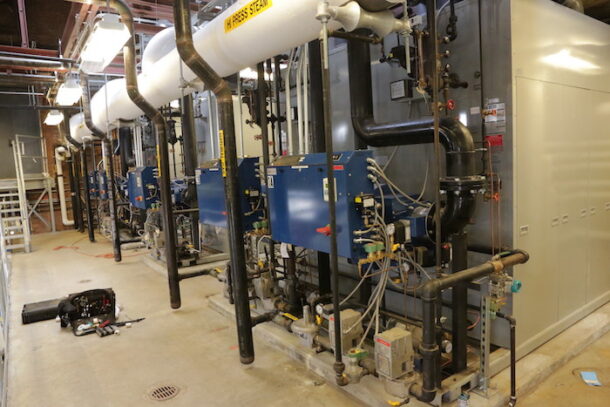
Bryan’s RV600 flexible water-tube steam boilers are a great fit for many commercial heat or process steam application. The systems offer 3,500,000 to 8,000,000 BTUH with forced-draft gas, oil or dual fuel. Image courtesy of Bryan Boilers.
By design, the concern of heat transfer fouling—typically in the form of accumulated mineral scale—is heightened. For that reason, fill-water quality and the steady monitoring and maintenance of water chemistry are essential to peak operation.
The accumulation of scale is by no means specific only to the water-tube design. Scale can accumulate faster because of the water-tube boiler’s lower water mass, but it’s still a concern across all heat exchanger types. “But, reduced water volume also equates to savings on chemical treatment,” added Blackwell.
Finally, the reduced volume of water affects the water-tube boiler’s ability to meet the call for sudden changes in heat demand. This shortcoming is often remedied by the addition of an indirect water storage tank.
Fire-tube advantages
Advantages include their simple construction and the ability to easily meet rapid fluctuations in the need for heat. As a lower cost alternative to water-tube boilers, they’re often used for smaller commercial or industrial facilities with lower operating pressures.
Fire-tube boilers are designed with water in the unit’s main vessel, achieving higher mass. Because of their higher water volume, system design also offers the benefit of a less urgent need to maintain tight control of water quality. If water quality deteriorates and isn’t corrected quickly, there’s less chance— when compared to water-tube technology—that system performance will be affected.
Another advantage to fire-tube boilers may be lower upfront cost. “However, said Blackwell, “In our market, there’s very little, if any, difference in pricing.”
Caveats
A fire-tube boiler’s higher water volume and lower flow rates also mean that they may offer less efficient heat transfer. Likewise, the greater water volume requires a longer wait for system start-up, and may also challenge the boiler’s ability to meet demand for constant water flow—and heat transfer—at peak conditions. Standby losses are greater because of the boiler’s higher volume of water.
The main disadvantage of fire-tube boilers is that they tend to have smaller capacities and can’t handle internal pressures over 250 psig (the steam capacity range of fire-tube steam boilers is approximately 5,000 to 75,000 pounds/hr.) Or, if configured as a hot water boiler, hot water capacity is between 2 million to 100 million BTUs.
Traditional, horizontal fire-tube steam boilers may offer a capacity as low as 690 pph—pounds (of steam) per hour. Traditional fire-tube steam boilers in a vertical configuration will go smaller—offering as little as 207 pph, for example.
Boiler Safety—be warned
Operationally, water-tube boilers are known to be safer than fire-tube systems. This is because of the much greater volume of water held within fire-tube boilers—containing as much as 10 times the volume of a water-tube boiler of similar capacity.

Burnham Commercial Boilers offers a convenient solution with efficient, easily portable, mobile boilers. Image courtesy of Burnham Commercial Boilers
When fire-tube boilers are inadvertently operated with low water volume, very dangerous risks can develop. Initially, the metal in the boiler warps and contracts. Then, if cold fill-water enters the boiler in a hot, low-water condition, the metal could rapidly expand, causing an explosion.
Should a similar scenario take place in a water-tube boiler with lower internal water volume, an explosion would be much less severe. In most instances— should fill-water enter a hot water-tube boiler with an insufficient fluid level— conditions would likely lead to metal fatigue, a crack, and leakage.
Service and maintenance
Some boiler designs are built to facilitate ease of service and maintenance. The assumption, however, is that a newly-installed boiler is ready for the rigors of duty, 24-7-365. Yet, all mechanical equipment is not created equal. Service and maintenance work ideally happens systematically to maintain optimal performance and efficiency—not to deal with challenges that arise as a result of faulty or compromised design.
Commercial boilers should be designed to ensure long-term durability and optimal performance. Ideally, the burner is mounted front and center, fully accessible and serviceable. Removable panels around the boiler should provide access to the burner chamber and entire heat exchanger. There should be no need to disconnect blowers or gas piping.
Commercial Condensing Systems
As with all technology, improvements emerge to enhance operation, durability or efficiency. The emergence of condensing capability—often going hand-in-hand with “turn-down” (or modulation, offering very efficient, partial firing)— are the most substantial enrichments to boiler systems in decades.
Condensing boilers are based on a remarkably simple concept. They achieve higher efficiencies by condensing the flue gasses. In contrast—in a conventional boiler, latent heat contained in the flue gas escapes through the flue vent. They’re also quite effective at reducing NOx, COx and other harmful emissions.
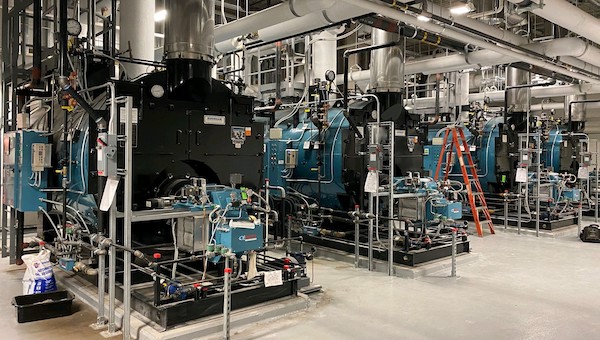
Burnham Commercial Boilers offers a convenient solution with efficient, easily portable, mobile boilers. Image courtesy of Burnham Commercial Boilers
Modulating condensing boilers (AKA “mod-con” boilers) earned “greatest achievement” recognition as a result of their dramatic contribution—pushing fuel efficiency from 80 percent for non-condensing boilers, and up into the 90+ percent range for mod-con systems. Condensing water-tube boilers achieve efficiencies of up to 98 percent, higher than most condensing fire-tube systems—a result of their better heat transfer. With modulation, they provide a range of firing rates to match the variable heating load of the building.
However, mod-con boiler efficiency depends on the temperature of the water returning to the boiler. The lower the return water temperature, the higher the efficiency. Low boiler return water temperature depends on the overall boiler system design, not just the boiler.
Condensing boilers cost 40 to 50 percent more, on average, than conventional systems. However, the difference in cost is typically recovered in four months to four years, depending on a wide range of variables. Substantial cost-saving incentives may apply.After the initial cost recovery period, the fuel savings are quite significant over the life of the boiler.
There are a few disadvantages. For instance, one fire-tube boiler design change involved the arrangement of internal tubing from a horizontal format, to vertical. The revision was warmly welcomed by facility owners and installers alike because their now-smaller size permitted movement through a standard door frame. As a result, the products of combustion and condensate were redirected: rather than gradually absorbing heat as flue gas passes through tubes, the contemporary vertical fire-tube burner sits inches away, forcing heat directly on the tube sheet, welds, and tube tops. All materials expand and contract as they’re heated and cooled, and these internal components of the vertical fire-tube boiler are no exception. The design tends to concentrate too much heat on metal components.
Cleanings and reparability
If a condensing boiler’s panels are easily removed, providing complete access to the entire heat exchanger, byproducts of combustion can be easily removed with a service brush. This is an important facet to maintaining a boiler’s original high-efficiency rating.
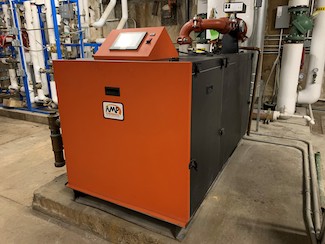
A Thermal Solutions AMP water-tube boiler is rated at 97% efficient. The stainless steel, modulating-condensing boiler line offers a size range of 1,000-4,000 MBH.
Should repair work be required, all components of the heat exchanger should be easily accessible for service or replacement—including even the possibility of changing one or more internal tubes in the field.
With properly isolated equipment, service work could and should be completed within hours, not days or weeks.
Systems that offer the greatest resistance to cleaning are those with tight, top access and—when opened—may have many welded tubes. Those that do typically require entirely new heat exchangers, sometimes costing as much as 60 percent of the original install.
Knockdown rewards
Knockdown condensing boilers were, for good reason, greeted enthusiastically by the commercial market. Some of these systems use no welds in securing tubing to the header.
The “knockdown” moniker stems from the ability to assemble or disassemble a boiler of any size with relative ease and precise repeatability. The systems arrive on jobsites, similar to old cast iron sectional boilers, or partially assembled based on space requirements.
Even elevator weight constraints pose no challenge to getting the boilers in place. If there’s a need to maximize mechanical room space, some systems are available with reverse construction models to optimize clearance space between units or to be placed side by side, to be serviced from outside.
Greg Hughes is the Internal Sales Manager, Thermal Solutions and Burnham Commercial. He can be reached at ghughes@heatingsolutionssales.com
Additional sources:
Jim Knauss – jknauss@burnhamcommercial.com (retired but now consulting) Engineer for Burnham Commercial (firetube merits)
Joe Tinney – jtinney@heatingsolutionssales.com Internal Sales Manager for Bryan Boilers (watertube merits)
Rick Constantino (rconstantino@bresales.com) – Owner/COO Boileroom Equipment Company
Theodore (Ted) Dreyer (TDreyer@WHGardiner.com) – Sales for Gardiner



